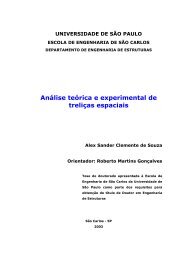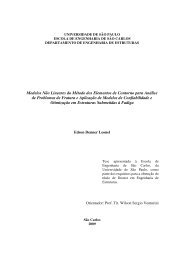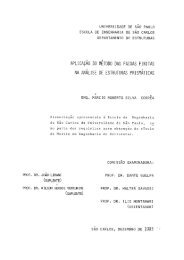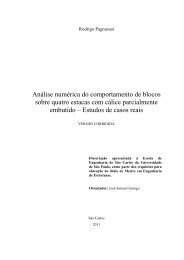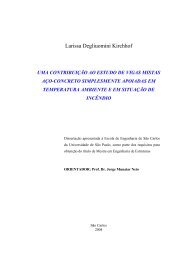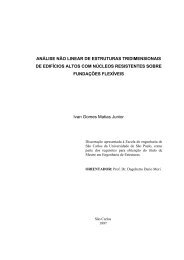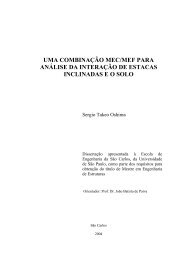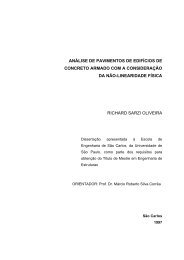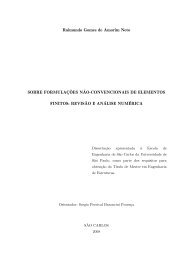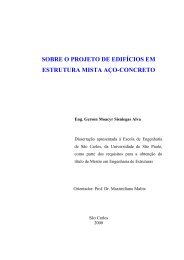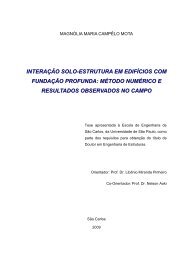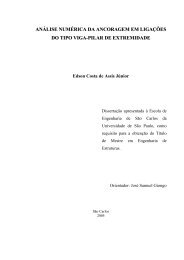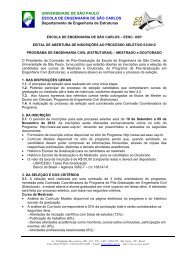o método dos elementos de contorno aplicado à ... - Sistemas SET
o método dos elementos de contorno aplicado à ... - Sistemas SET
o método dos elementos de contorno aplicado à ... - Sistemas SET
You also want an ePaper? Increase the reach of your titles
YUMPU automatically turns print PDFs into web optimized ePapers that Google loves.
Fazendo-se a discretização do <strong>contorno</strong> em Ne <strong>elementos</strong>, e substituindo-se as<br />
variáveis por suas aproximações em cada elemento dadas por (4.6) e (4.7), a equação (4.13)<br />
fica:<br />
Ne<br />
⎡<br />
⎤<br />
T<br />
KQwQ ( ) ( ) + ∑ ⎢∫<br />
p*( QP , ) φ ( Pd ) Γ⎥U<br />
j=<br />
1 ~ ~ ⎣⎢<br />
Γ<br />
⎦⎥<br />
~<br />
=<br />
Definindo:<br />
Ne<br />
∑<br />
j=<br />
1<br />
⎡<br />
⎢<br />
⎣⎢<br />
∫<br />
Γ<br />
⎤<br />
*<br />
T<br />
u ( Q, P) φ ( P) dΓ⎥P ~<br />
⎦⎥<br />
+<br />
∫<br />
N<br />
j<br />
~ ~<br />
+<br />
( ) ( )<br />
∗<br />
gpw ( )<br />
Ω g<br />
Qpd , Ω g p<br />
N<br />
j<br />
N c<br />
∑<br />
i=<br />
1<br />
+<br />
N c<br />
∑<br />
i=<br />
1<br />
( , ) ( )<br />
*<br />
R Q P w P<br />
ci ci<br />
* ( ) ( , )<br />
R P w Q P<br />
ci ci<br />
+<br />
=<br />
51<br />
(4.18)<br />
j T<br />
h ( Q) = ∫ p*( Q, P) φ ( P) dΓ<br />
, (4.19)<br />
~<br />
Γ ~ ~<br />
j *<br />
T<br />
g ( Q) = ∫ u ( Q, P) φ ( P) dΓ<br />
(4.20)<br />
~<br />
Γ<br />
~<br />
∗<br />
e tQ ( ) = ∫ gpw ( ) ( Qpd , ) Ω g ( p)<br />
Ω g<br />
a equação (4.18) po<strong>de</strong> ser rescrita da seguinte forma:<br />
( )<br />
Ne + ∑<br />
j=<br />
1<br />
j<br />
KQwQ ( ) h( QU )<br />
N e<br />
j N<br />
= ∑ g ( Q) Pj+<br />
j=<br />
1<br />
~ ~<br />
~<br />
N c<br />
∑<br />
i=<br />
1<br />
~<br />
~<br />
N<br />
j<br />
N c<br />
, (4.21)<br />
*<br />
+ ∑ R ci ( Q, P) wci( P)<br />
=<br />
i=<br />
1<br />
* ( ) ( , )<br />
R P w Q P<br />
ci ci<br />
+ t(Q) (4.22)<br />
Consi<strong>de</strong>rando-se o ponto <strong>de</strong> colocação em Q, soma-se as influências h Q<br />
j<br />
( ) e<br />
g Q<br />
j<br />
( ) <strong>de</strong> to<strong>dos</strong> os <strong>elementos</strong>, agrupando-se os coeficientes multiplicativos <strong>de</strong> um mesmo<br />
~<br />
valor nodal, para to<strong>dos</strong> os nós do <strong>contorno</strong>. Assim, po<strong>de</strong>-se escrever a equação (4.22)<br />
matricialmente:<br />
~



